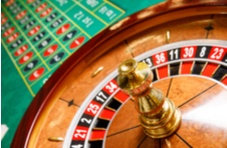For many years, roulette players have been aware that a biased wheel can give a player the advantage in roulette games. Now that casinos are employing high-tech online slotsmethods to guard against such wheels, some people are looking elsewhere to see how they can boost their chances of winning.
Some people believe the theories that say that it’s possible to exploit the way that the roulette wheel and the betting table are laid out to gain an advantage. Mathematicians have examined the math and share their findings.
House Edge
It’s true that in roulette, each spin is independent of the next. The house edge is in the house’s favor and in most cases the casino wins -- as opposed to a game like blackjack where the probabilities change every time that the cards are dealt. If someone is trying to promote the idea that you can make wagers on the layout in a way that guarantees you wins, be careful. It’s not possible .
Layout
The layout of a roulette wheel is like a dartboard. Even when roulette was designed hundreds of years ago, the designers created the layout so that it would exhibit certain properties -- both for the one-zero European wheel and the two-zero American wheel.
Most savvy roulette players are aware that the difference between the European and American wheels involves the number of zero pockets on the wheel. The extra zero pocket in an American wheel gives the house an edge of 5.26%, so on average, you would expect to lose 5.26% of any money that you bet over the long haul. The European wheel has a house edge of 2.7%, significantly better for the player. (is it any wonder that most casinos make it much easier to find and play with an American wheel?).
Of course, this is only statistics. Not everyone (or anyone) who plays roulette loses 5.26% or 2.7% of their bets. Some lose more, some win - the percentages stated are the mathematical averages when many many players are figured into the calculation.
On each wheel the numbers are arranged differently. There are some similarities in the patterns. On both wheels, the black and red numbers alternate around the wheel. If you were to remove the zeros, the American wheel would have consecutive reds and blacks. The wheels are also structured so that the high numbers (19-36) and the low numbers (1-18) alternate as much as possible.
This is only violated where the 5 sits next to the 10 (both low numbers) on a European wheel. The American wheel is considered not as balanced as the European wheel because on the American wheel, there are many examples where this rule is violated. Odd and even numbers are distributed as evenly as possible on both wheel but there are multiple violations of this rule on both wheels.
In addition, there are two other interesting symmetries on the European wheel. Black high numbers and low red numbers are on one side of the zero, and the low black numbers and high red numbers are on the other side. Second, the second dozen sequence 29-7-28-12-35-3-26-0-32 contains no numbers between 13 and 24. It’s possible to place a bet on the whole of the second dozen, with odds of 2-1.
Beating the Math?
If you search on Google you’ll find thousands -- maybe millions -- of roulette “systems.” Some seem easy, some are complicated, some are completely described and others lack good descriptions.
Regardless of the exact betting system, such a system should really be a combination a money management strategy and a playing technique. Probably the best known money management technique is the Martingale Strategy. The Martingale system guarantees that you’ll win money as long as you don’t hit the table limit, and as long as you have enough of a bankroll to double your bet after every loss. The Martingale system, which is the most famous Roulette system and has pulled many a gullible gamer into its “logic,” is probably the quickest way to bankruptcy known to man.
There are other “strategies” but they all bring with them the same problems. Assuming that each number on the wheel has the same probability of being selected, according to the maths, the casino will always win. The system may work in the short term and it may sound logical. But when a number comes up on which you have not bet, you will lose and the casino will move towards its win expectation, be it 2.7% or 5.26%.
Another system involves covering more than half of the numbers. However, when one of the numbers does not turn up (which happens about 50% of the time), you lose all of your wagers. Not only do you not win that round, but your loss can wipe out most of your previous wins.
In short, any system that has come up to date, other than the biased wheel system, gives the casino the win expectation. The best “system” in this true game of chance involves placing a single chip on the same number every time and hoping that it appears more than it should during your gaming session.
In short, the math of roulette is, indeed, there. The best strategy is to go into the gaming session with the knowledge that you’re playing for fun. Pick your numbers at random and trust your luck and enjoy the excitement of the spinning wheel.




